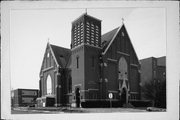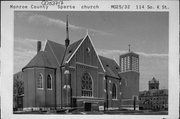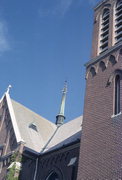Property Record
114 S K ST
Architecture and History Inventory
| Historic Name: | ST. PATRICK'S CATHOLIC CHURCH |
|---|---|
| Other Name: | St. Patrick's Catholic Church |
| Contributing: | |
| Reference Number: | 53717 |
| Location (Address): | 114 S K ST |
|---|---|
| County: | Monroe |
| City: | Sparta |
| Township/Village: | |
| Unincorporated Community: | |
| Town: | |
| Range: | |
| Direction: | |
| Section: | |
| Quarter Section: | |
| Quarter/Quarter Section: |
| Year Built: | 1905 |
|---|---|
| Additions: | 1922 |
| Survey Date: | 1989 |
| Historic Use: | church |
| Architectural Style: | Early Gothic Revival |
| Structural System: | |
| Wall Material: | Brick |
| Architect: | A.E. PARKINSON |
| Other Buildings On Site: | |
| Demolished?: | No |
| Demolished Date: |
| National/State Register Listing Name: | Not listed |
|---|---|
| National Register Listing Date: | |
| State Register Listing Date: |
| Additional Information: | St. Patrick's Church was built in 1905 after a fire destroyed the church's former building on West Main Street. This earlier church was a wooden structure which was erected down near the Milwaukee Depot in 1867 and later, in 1877, moved to its West Main Street site. The site for the new church was owned by John Teasdale and purchased from him on May 11, 1905. The cornerstone for the new St. Patrick's Church was blessed and laid by Bishop Schwebach of La Crosse on Sept. 24, 1905, and the first mass was said in the church on Nov. 18, 1906. The church was officially dedicated on June 7, 1907. The only alteration to the church since its erection in 1905 came in 1922, when the steeple of the church was struck by lighting. It was never replaced. St. Patrick's Church gains local historical significance under Criterion A. Although a religious structure, and not associated with any of the themes outlined in the district, it acquires significance under exception A which recognizes the historical role of religious buildings. The development of the church appears to have been a very stable influence in the community and appears to parallel others in western Wisconsin. It possesses its historical significance ffrom the date of its completion and the beginning of its actual use in 1905 to the present. The end date recognizes its continued function as a church. St. Patrick's Catholic Church is characterized by the steep gable roofed form, buttresses and the pointed arched windows and door typical of the Gothic style. The sculptural form displayed by this brick church is ornamented by arcades of pointed arches along the eaves of the roof and the tower and also below the strong courses that horizontally divide the brick elevations. Pointed arched windows featuring refoil tracery and stained glass lights and a Bedford stone pointed arched frontispiece ornamented by slender pinnacles on the front entrance further characterize this Gothic styled building. The interior dimensions of this cruxciform church include a 45 foot x 120 foot nave and 8 foot transepts. The interior of the church was fitted with pews by the egid Hackner Company of La Crosse according to the design of the architect. The stained glass windows were made by the Munich Art Studio of Chicago. The present St. Patricks Church, built to replace the earlier frame church destroyed by a fire in January of 1905, was designed by the La Crosse architectural firm of Parkinson and Dockendorff. The building was constructed by J.G. Schneider of Arcadia, WI. This early 20th century interpretation of the Gothic Revival style was altered when the tall slender spire was demolished when a fire burned everything down to the brickwork of the tower in 1922. St. Patricks Catholic Church is significant under criterion C as an example of the Gothic Revival. One of only four extant Gothic styled historic churches remaining in the community, St. Patrick's, competed in 1907, is representative of the early 20th century Gothic Revival style. St. Johns Episcopal Church at 400 North Water is a mid-19th century example while the Methodist Episcopal Church at 210 North Court is representative of the late Gothic style. The Evangelical United Bretheran Church at 230 North L Street, another Gothic Revival styled church built in the same period as St. Patricks, is a frame interpretation of the style. Although the integrity of St. Patricks was altered when the spire was demolished, it continues to be a significant historic property because there are only a few extant historic church buildings with integrity in Sparta that are still functional. |
|---|---|
| Bibliographic References: | (A) Sparta Herald 1/25/1905; 3/13/1905; 4/18/1905; 6/4/1907; 2/21/1922. (B) Cornerstone. (C) La Crosse Tribune 3/25/1995. (D) Sanborn Insurance Map 1889, 1894, 1900, 1911, 1922, 1931. (E) Middleman, Julia E., "Summary of Sparta School History, 1952-1980: With Bits of Early Spart History," (1980) Typescript, pp. 17-21. (F) "St. Patrick's Congregation," Monroe County Historical Society. Vol. 2, No. 3 (July 1977): 1-2. (G) Sparta Volunteer Fire Department, "Sparta Volunteer Fire Department Centennial, 1879-1979, May 19, 1979 (Pamphlet), p. 39-40. (H) Sparta Centennial Celebration Committee, Sparta Incorporation City Centennial: 1883-1983 (1983), unpublished pamphlet, p. 12. (I) Monroe County Democrat "Sparta Up-To-Date" 6/30/1899:12. (J) Richards, Randolph A., History of Monroe County, Wisconsin: Past and Present, Including an Account of the Cities, Towns and Villages of the County. Chicago: C.F. Cooper & Co., 1912, p. 326-328. |
| Wisconsin Architecture and History Inventory, State Historic Preservation Office, Wisconsin Historical Society, Madison, Wisconsin |



